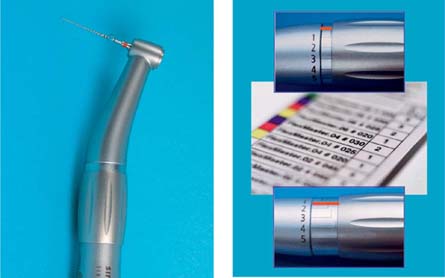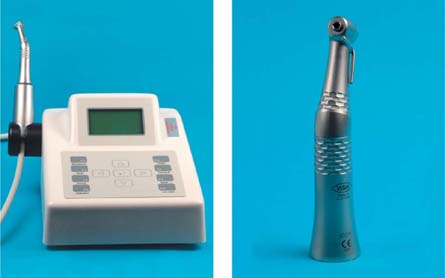21 Power-driven Instrumentation Systems: Recent Advancements
Since the end of the nineteenth century, numerous attempts have been made to develop power-driven instrumentation systems that would provide an appropriate and effective alternative to conventional manual root canal instrumentation.
With the introduction of NiTi instruments for root canal instrumentation in 1988 by Walia et al., a new era began. The fully rotating (360°), power-driven instrumentation files made of NiTi alloys led to significant improvements for mechanical systems (Schäfer, 2001). The most significant advantage of this technique is the excellent instrumentation of severely curved canals, with significant savings in clinical root canal preparation time (Bryant, 1999).
A problem, however, in comparison to the purely manual use of stainless-steel instruments is the high risk of fracture, which necessitates torque-limited power (Hülsmann, 2002).
21.1 Handpiece
Torque-limited handpiece (SIRONiTi). The clutch mechanism (right) allows selection of the desired torque interval.
21.2 The motor
Torque-regulating motor (EndoStepper) with the appropriate handpiece (right). The torque is selected via a preprogrammed system.
To avoid the instrument becoming stuck and fracturing within the root canal, the instrumentation must be performed at a low constant speed (usually approximately 300 rpm) (Hülsmann, 2002).
In addition to the experience of and careful instrumentation by the clinician, as well as the speed, torque also influences the risk of instrument fracture (Yared, 2001). For this reason, numerous technical solutions incorporating limitations on torque have been tried to reduce the fracture rate. Today’s instruments comprise torque-limited handpieces powered by torque-regulated electric motors.
The torque limitation controls the rotation of the instrument within the root canal, as this is interrupted the instant that frictional resistance to the file exceeds the fracture limit of the instrument (Merte, 2003).
To overcome the above problem, root canal files of varying mechanical capacity are grouped depending on the level of clinical safety. The weakest instrument wi/>
Stay updated, free dental videos. Join our Telegram channel

VIDEdental - Online dental courses




